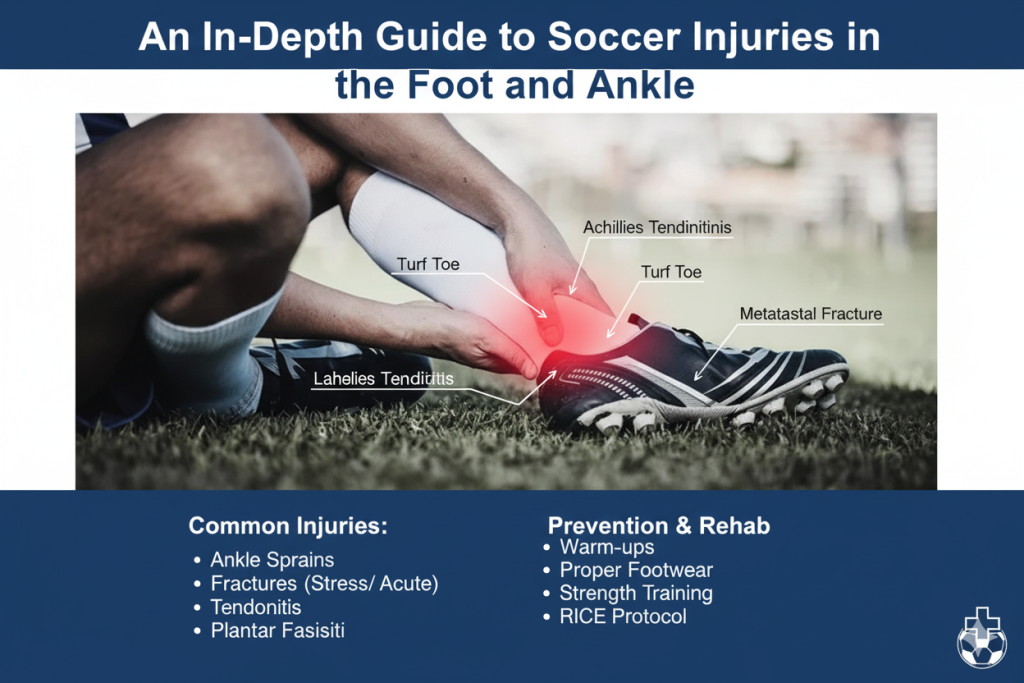Soccer is a beautiful game millions play worldwide, from grassy school fields to professional stadiums. Yet, beneath the spectacle and passion, soccer places a real risk upon players in the form of foot and ankle injuries. The hard running, side-to-side cutting, and physical takedowns make it a hard-hitting sport for the feet. With this, athletes and enthusiasts alike become aware of the risks involved, which is always a crucial first step towards prevention and recovery. So now, let’s take a look at what’s lying in wait for you on that soccer pitch, and how you can safely play on it.
The Hazardous Pitch: Soccer’s Most Common Injuries
Of course, before delving into details, one must not forget the constant complaints of injuries players go through. At the top of these are strains and sprains, especially with many rolls and twists of the ankle that stretch or tear the ligaments. Also common are the metatarsal fractures often tagged “footballer’s fractures”-and Achilles tendonitis and plantar fasciitis, among a host of other afflictions that randomly befall players, even the most seasoned, as fast as the tempo of the game itself.
Addressing the Worst Case Scenario Soccers
As for the worst kind of injury a soccer player can experience, it would be quite subjective and relative from one player to another. However, some would say that ACL tears and serious fractures are highly debilitating. Such kinds of injuries require extensive recovery times and, at times, career-changing. A bad tackle or an awkward fall, and in an instant, a player’s world would turn upside down.
On the Body’s Frontline: Injury Hotspots in Soccer
The lower extremities bear the brunt in soccer. The knees, ankles, and feet are very commonly affected areas. This trio has to bear most of the jolts from long-distance running, jumping, and tackling. All these repetitive strains and high-impact activities make these areas particularly prone to both acute and overuse injuries.
The Scale of the Problem: Soccer’s Injury Rate
But in terms of injury rates, soccer lags behind American football but is notoriously much more hazardous than a few other team sports. The injury rate nonetheless stands at an alarming rate; one study showed that the rate in youth soccer is as high as 2.4 injuries per 1,000 hours of playing time. Even with professional training and conditioning, the risk always lurks large in every game gamble on health.
An Anecdote of Prevention and Recovery: Playing Through Pain
Now, imagine a player, for example, Mia, who has been playing soccer since she could walk. Passionate and driven, she was on the fast track to an illustrious playing career. That is, until a mistimed tackle at a regional game sent her crashing to the ground. The diagnosis: a torn Achilles tendon-a devastating blow not just physically but mentally as well.
Surgeries and months of physical therapy line up in Mia’s road to recovery. But the key to her successful comeback was twofold: great adherence to a rehabilitation plan and newfound respect for prevention against injury. From tailored exercises that strengthen ankles to a disciplined warm-up routine before every game, Mia learns that prevention is very much a part of the game as scoring goals.
The Game Plan for Prevention and Management
Prevention is better than cure—a proverb perfectly suited to soccer-related injuries. Proper warm-ups, strength training, and flexibility routines are non-negotiable for injury prevention. Secondly, proper footwear fitted for the ground conditions and personal comfort can reduce the incidence of foot and ankle injuries.
If an injury occurs, careful attention using R.I.C.E. (Rest, Ice, Compression, Elevation) acutely is important. Early medical evaluation is critical for a thorough diagnosis and to initiate an appropriately designed rehabilitation plan.
Key Takeaway: Soccer Safety is a Team Sport
Finally, recognize that prevention and management of all soccer foot and ankle injuries is everyone’s business. Any player, coach, and medical team member might have a potentially very significant role to play in reducing the incidence of such injuries by teaching techniques correctly, allowing proper time for rest and recovery, as well as using other ways to protect their fellow competitors in this contact sport.
They all should be informed about risks, prevention, and recovery measures that might arise. With due care and diligence, the risks can be significantly reduced, and the fun of the game is not spoiled for anyone by preventable injuries.
Soccer, being physically demanding, is also a sport of high reasoning; it’s about playing skillfully as much as it’s about playing sensibly. Enjoy the game, but not at the cost of your prime assets-your feet and your ankles. After all, they are your only link with the very ground that witnesses every goal, every triumph, and every moment in this beautiful game.




